#archival science
Text
Creating Your Own History: Archival Themes in "The Watermelon Woman" [Part 1]
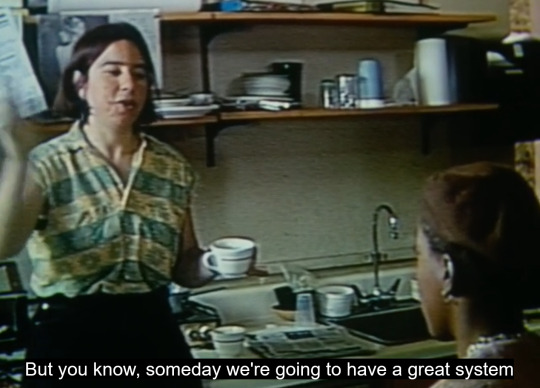
An archivist speaks to the film’s protagonist about having a “great system” to organize archival records within the community archive.
The Core Values Statement of the Society of American Archivists says that archivists should expand access, respect diversity found in humanity, and advocate for archival collections that reflect humanity’s complexity. [1] The reality is often different from that ideal in a field that is overwhelmingly White, as a recent article about Black archives pointed out. [2] This is evident in Cheryl Dunye’s 1996 romantic comedy-drama film, The Watermelon Woman, which the Library of Congress added to the National Film Registry in December 2021 for being “culturally, historically, or aesthetically significant.” [3] The film follows the story of one Black woman’s determined effort to create her own history and connect with the past. Although this eighty-six-minute mockumentary is over twenty-six years old, its themes of archival limits, power, silences, erasure, and fabrication continue to resonate today.
Reprinted from The American Archivist Reviews Portal. Thanks to Rose and Stephanie for their editing of this article! It was also posted on my Wading Through the Cultural Stacks WordPress blog on Jul. 5, 2022. This review contains some spoilers for the film The Watermelon Woman.
In the film, Cheryl Dunye plays a videographer (also named Cheryl Dunye) who works at a video rental store in Philadelphia with her friend Tamara (played by Valarie Walker). Cheryl watches a videocassette of an old 1930s film, Plantation Memories, and becomes interested in the character Elsie, a stereotypical ‘mammy’ character credited as “The Watermelon Woman.” She then strives to learn more about the actress who played Elsie. One of the first places Cheryl looks is in the basement of her mother’s house. Cheryl tells the audience that her mother, played by Irene Dunye, who is Cheryl’s mother in real life, throws nothing away. She says that Irene’s filing system needs updating. Her mother tells her about the films she watched growing up in the 1930s and notes that she saw “Elsie” singing in some clubs.
Cheryl continues her dogged search by talking to a person with a collection of old Black films and then traveling to the local public library, likely the Free Library of Philadelphia. After perusing the stacks, she checks out as many books as she can and talks to the reference librarian, a White man who is played by David Rakoff. Wanting information about the Watermelon Woman, she encounters her first archival limit, which scholars Sue McKemmish, Michael Piggott, Barbara Reed, Frank Upward, Jocelyn Fenton Stitt, and Sarah Tyson define as barriers created when documents pass into the hands of archival institutions from those who created them, inhibiting attempts to use records to tell family stories and circumscribing efforts to reclaim records about enslaved people. [4]
The librarian dismissively tells Cheryl to check the “Black,” “film,” and “women” sections of reference books for information about the Watermelon Woman. With much prodding, he eventually searches his computer and identifies Martha Page as the film’s director, telling Cheryl that information about Page is on a reserve desk on another floor. Although reserve desks serve students and faculty with materials typically meant for university courses, Cheryl is given an exception and is able to access the relevant information for her research. Yet, she is still unsuccessful because the materials she looks at don’t have exactly what she is looking for.
© 2022 Burkely Hermann. All rights reserved.
Notes
[1] “SAA Core Values Statement and Code of Ethics,” Society of American Archivists, accessed February 20, 2022, https://www2.archivists.org/statements/saa-core-values-statement-and-code-of-ethics.
[2] Harmeet Kaur, “How Black Archives Are Highlighting Overlooked Parts of History and Culture,” CNN, February 19, 2022, https://www.cnn.com/2022/02/19/us/black-archivists-history-culture-cec/index.html.
[3] Nancy Tartaglione, “National Film Registry Adds ‘Return Of The Jedi’, ‘Fellowship Of The Ring’, ‘Strangers On A Train’, ’Sounder’, ‘WALL-E’ & More,” Deadline Hollywood, December 21, 2021, https://deadline.com/2021/12/national-film-registry-2021-list-star-wars-return-of-the-jedi-fellowship-of-the-ring-sounder-nightmare-on-elm-street-wall-e-1234890666/. The film is available for rent on platforms such as Vimeo, Hulu, Apple TV, Prime Video, and BFI. I watched it, using my library card, on Kanopy. It can be watched free of charge on the Internet Archive.
[4] Sue McKemmish, Michael Piggott, Barbara Reed, and Frank Upward, Archives: Recordkeeping in Society (Amsterdam, Netherlands: Elsevier, 2005), 205; Jocelyn Fenton Stitt, Dreams of Archives Unfolded: Absence and Caribbean Life Writing (New York: Rutgers University Press, 2021), 42; Sarah Tyson, Where Are the Women?: Why Expanding the Archive Makes Philosophy Better (New York, Columbia University Press, 2018), 148.
#the watermelon woman#archivists#archival science#archival studies#archival#archiving#archives#1990s#1990s films#indie films#national film registry#library of congress#mockumentary#cheryl dunye#black lesbians#lesbians#lgbtq#1930s films#racial stereotyping#archival limits
60 notes
·
View notes
Text
I love you archives I love you dusty books I love you ugly books I love you court documents i love you posters of gay sleuths I love you naked men by the river I love you football team from 1950s I love you stacks of old newspapers I love you bricks wrapped in duct tape I love you VHS of la bamba I love you Spanish men who fly 12 hours across the ocean to a foreign country to read musty books and look at spurs and see the largest collection in the US of this material I love this life
#i started my internship at the archives this week#i love it#archives#archive#library#libraries#books#library science#archival science#archival studies#historians#archivist#i just love the archives even if none of these collections are something im obsessed with#jay jabbers
101 notes
·
View notes
Text
I've never fallen in love with a subject so fast like I did with Archival Studies.
I love you, archives, I love you archival bonds, I love you laws and rules about formation, management and preservations of documents. I love you, I love you, I love you.
#archivistica#archival studies#university student#the things this subject does to the chemical in my brain i swear#uni stuff#I am seriously thinking of finishing with my master degree and try to enter in that specialising school for this aaaaa#archival science
3 notes
·
View notes
Text
Our Digital Legacy: an Archival Perspective (Moss & Gollins, 2017)
Author(s): Michael S. Moss and Tim J. Gollins
Date: 2017
Abstract:
Many have discussed and debated the preservation of traces from our digital world, mostly from a technical perspective. A great deal of this discussion has been predicated on the false assumptions that little will survive (the so-called digital black hole) and that rapidly changing file formats and software upgrades will make what survives difficult, if not impossible, to read. This narrative has been coupled with alarmist stories about the high cost of digital curation in trusted digital repositories. Taken together, all this scaremongering has diverted attention from the other core principles of archival science: appraisal (what to keep), sensitivity review (identifying material that cannot be disclosed for ethical or legal reasons), and access.1 The way that archival science uses these core principles to respond to the “supernova” of digital material that will actually survive will define our digital legacy.
Find the full article here!
#research#journal article#scholarly articles#archive#archive studies#archive practices#archival practices#digital studies#digital narrative#digital history#web archive#accesibility#archival science#digital legacy#narrative
2 notes
·
View notes
Text
How data expertise is empowering endangered languages
#Cherokee #endangered #language #linguistics #data #DataManagement #DataScience #archives #archiving #revitalization
#Cherokee#language#linguistics#endangered languages#data#data management#data science#archiving#archival science#archives#revitalization
5 notes
·
View notes
Text
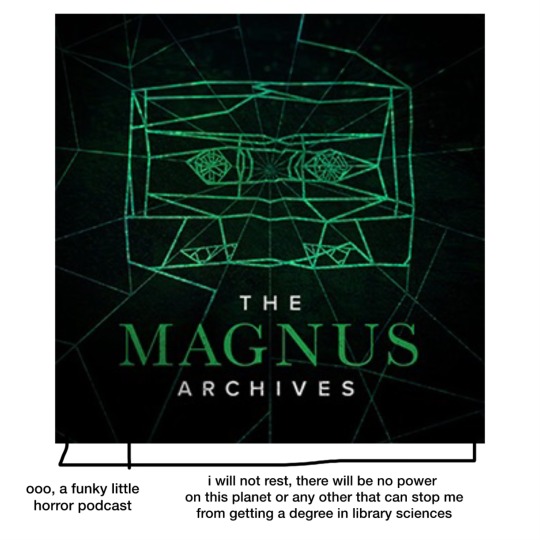
pretty normal podcast listening experience i think,
#the magnus archives#jonathan sims#the archivist#tma podcast#the magnus protocol#rusty quill#horror podcast#tma jon#library science#audio drama enjoyer/deragatory
4K notes
·
View notes
Text

(x)
#archive of our own#ao3 stuff#ao3 quotes#archive of our own quotes#fanfic#fanfic quotes#funny#ao3#ao3 tags#the Medical Science in this is NOT peer reviewed
6K notes
·
View notes
Text
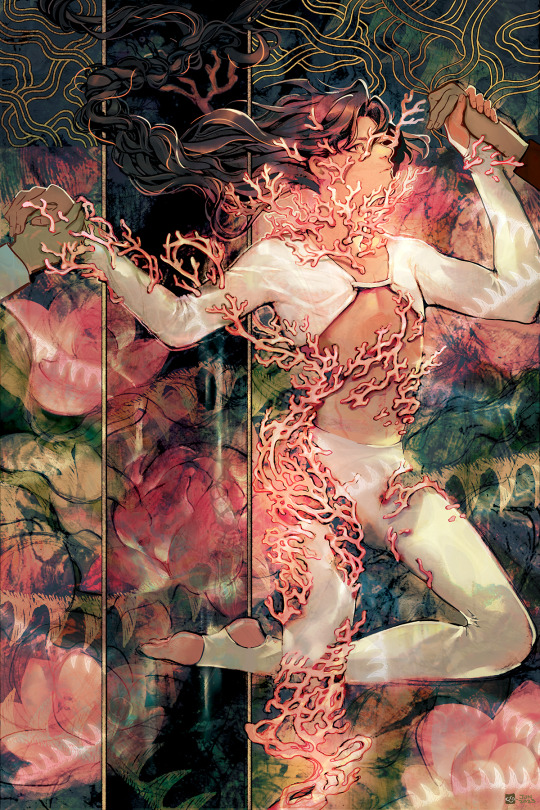
This advertisement is for The Archive Undying—a debut science fantasy epic from Emma Mieko Candon, and book one in their Downworld Sequence, featuring commissioned fanart of Sunai, the book's main character. The artist is Caitlin Ono.
WHAT IT’S ABOUT
Plugged into his AI god when its corruption renders him unfortunately immortal, sad gay disaster Sunai takes a die-again-or-die-trying approach to his tragically unending life. Despotic police states want to leash him and giant robots want to eat him, but reuniting with the small handful of people he cares about is what’s actually horrifying.
Adrift in the wilds, Sunai makes several unwise decisions such as:
Scavenging old ruins haunted by hostile fragments of another shattered technological deity
Allowing his mind to become further compromised
Sleeping with his mysterious employer for information and fun
Joining a haphazard crew of pirates who all have different motives for hunting a feral remnant of the same god that cursed him, all those years ago
This brain-melting series-starter is like a Neon Genesis Evangelion AMV set to a bass-boosted cover of George Michael’s "Careless Whisper."
#caitlin ono#fanart#the archive undying#emma mieko candon#immortal and emotional about it#gay books#mecha fiction#science fiction#science fantasy#tordotcom publishing#tordotcom#books#bookblr#lgbtqia+#giant robots#mecha
4K notes
·
View notes
Video
youtube
This is why your old game carts get corrupted
0 notes
Text
Is Peridot an unintentional archivist, records manager, or something else entirely? [Part 1]

Peridot, shown in her debut episode "Warp Tour," making a log of her trip to Earth and what she saw while she was there.
So, I recently began rewatching Steven Universe, starting at season 1, and I realized even more archival themes than what I had previously concluded, beginning with one of the characters, Peridot. Some readers may remember I wrote about Steven Universe before, at the beginning of this year, noting the presence of VCRs, their preservation, other records within the series, the special library of Buddy Buddwick, and archival records used in defense of Steven at his trial, to name a few aspects.
Reprinted from my Wading Through the Cultural Stacks WordPress blog. Originally published on Dec. 2, 2021.
However, I was mainly relying on memory in writing that post, and its different once you begin watching a series again. As such, this post will be focused on one specific character, Peridot, and whether she is an unintentional archivist, records manager, or something else entirely in the series as a whole. Warning here that this post will give spoilers for part of the show.
In episodes within seasons 1 and 2 of Steven Universe, Peridot often records her progress with Gem experimentation and the cluster on her "finger screens." She is first shown making logs in her debut episode [Warp Tour] and makes another log in the episode "Keeping it Together," before Steven, and his friends, the Crystal Gems, chase her across the Prime Kindergarten. [1] Unfortunately, her screens and limb enhancements are thrown into the water in the episode "Catch and Release" by Amethyst. In the following episode, "When it Rains," she tells Steven she doesn't know anything without her screen and tells him that all her logs up to a certain date are backed up in the Prime Kindergarten. She also tells Steven she read over a few hundred years of reports and displays her records which show many attempts at artificial fusion, prototypes for an artificial fusion that would have destroyed the Earth, the Cluster.
Following this, she gets an audio tape recorder, making logs for her life on Earth, her experiences, her attempts to get along with the Crystal Gems (Amethyst, Garnet, and Pearl), and more. [2] This until the episode "Barn Mates" when Lapis destroys it after Peridot gifts it to her in hopes of becoming friends with her. The audio tape recorder becomes an important part of her character development as she adapts to living on Earth rather than living on Homeworld. In the process, you could say that the recordings that Peridot does are archival records.
As I noted in my previous post about Steven Universe on this blog, Peridot notes that she had backed up her logs before, finding information on Gem fragments from reports. In the episode "It Could've Been Great" she goes through an old Gem computer system to find information about the cluster, Gem locations, and the planned Earth colony. The question remains, is Peridot an archivist, albeit unintentionally? That is what I want to answer in the rest of this post, divided into two parts. The second part will be published tomorrow.
© 2022 Burkely Hermann. All rights reserved.
Notes
[1] Peri is using communication devices in "Friend Ship" as well.
[2] This shown in the episodes "Log Date 7 5 12" and "Barn Mates" for instance.
#peridot#steven universe#archivists#records managers#records management#archival science#archival studies#archival#archives#recordkeeping#recordkeepers#audio tapes#audio tape#pop culture#reviews
24 notes
·
View notes
Text
Just submitted my letters of recommendation to the library science program. Please wish me luck in my endeavor to join archival studies 😭
#mlis#library science#libraries#library#book#archives#archivist#archival science#archival studies#jay jabbers#i gotta wait three weeks at least to find out if i made it omg im so ANXIOUS
8 notes
·
View notes
Text
Archivist woes
Horror of horrors, my colleague told me to just ignore that particular stack of papers since "it wouldn't take up much room". Excuse me, I plan to still be working here when we move offices, tidying should start sooner rather than later for the sake of everyone's sanity (but I'll admit, mostly mine).
In other news, I went mad with a paper shredder today, got rid of 12 boxes over the course of 1,5 hours.
fun fact, contrary to popular perception, stacks of useless paper is the bane of an archivist's existence.
0 notes
Text
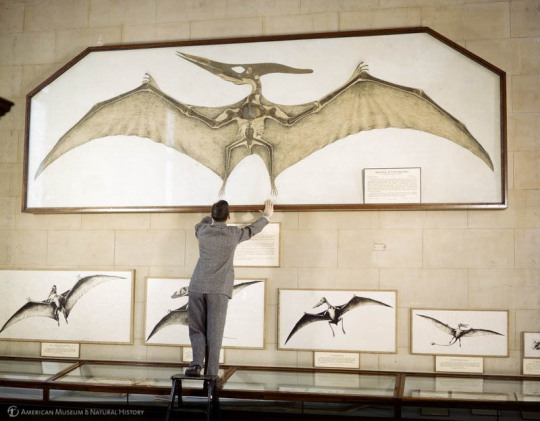
It’s a bird! It’s a plane! It’s… a dinosaur? Nope to all of the above. This Fossil Friday, let’s talk about pterosaurs—the first animals with bones to evolve powered flight. Though they were related to dinosaurs, pterosaurs evolved on a separate branch of the reptile family tree. They ruled the skies for more than 150 million years, evolving into dozens of different species. Some were as small as a paper airplane while others, like Pteranodon pictured here in the Museum's Hall of Late Dinosaurs circa 1940-1960, had a wingspan of more than 20 ft (6 m).
Along with other large pterosaurs, Pteranodon longiceps was first discovered in western Kansas, near a chalk formation called Monument Rocks. Today the region is dry, but at the time this species lived, about 85 million years ago, central North America was covered by a seaway. This large pterosaur likely spent its days flying over the sea. Unlike early species of pterosaurs, Pteranodon and many other Cretaceous-era species didn’t have any teeth. In fact, its genus name means “winged and toothless,” while the second name, longiceps, means “long-headed.”
Today, you can find Pteranodon in the Hall of Vertebrate Origins. We're open daily from 10 am-5:30 pm! Plan your visit.
Photo: Image no. ptc-217 © AMNH Library
#science#amnh#museum#dinosaur#fossil#nature#natural history#paleontology#animals#pterosaur#reptile#did you know#fact of the day#ancient animals#prehistoric animals#vertebrates#fossil friday#pteranodon#archives#flashback friday
638 notes
·
View notes
Note
Brainstorm and Nightshade Malto meet. Shenanigans ensue
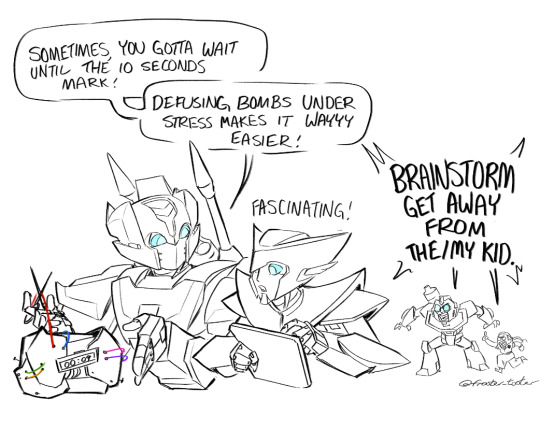
I need them in Earthspark so badly, you guys have no idea
Also had some fun designing my own little rendition version of Earthspark BS and Percy lol
#I need them in the show please it would be absolute science chaos between Percy Brainstorm Tarantulas Nightshade Shockwave and Wheeljack#imagine the shenanigans.. it would be so goodddd#also I just need TC and Buster in the show because pLEASE..#IGNORE THE MASSIVE TYPO I MADE IN THE FIRST VERSION AHAHAHH SHHHHHHH#transformers#maccadam#maccadams#transformers fanart#brainstorm#nightshade#dot malto#perceptor#transformers earthspark#tf earthspark#tfe#earthspark fanart#tfe nightshade#frootertooter archive
1K notes
·
View notes
Text
Katherine Johnson: The Mathematician Who Launched Astronauts into Space and Women into STEM 🚀👩🚀

In the vast expanse of the cosmos, where men first dreamed of reaching the stars, Katherine Johnson calculated the path that would get them there. This story isn't just about trajectories and orbits; it's about a woman whose brilliance in mathematics helped break the barriers of space and gender.

Johnson's journey began in White Sulphur Springs, West Virginia, where her curiosity and intelligence shone from an early age. Despite encountering segregation and sexism, she charted a course that would lead her to NASA, where her skills became indispensable to the success of the U.S. space program. Her calculations were critical to the success of the Mercury missions, including John Glenn's pioneering orbital flight, for which he specifically requested Johnson verify the computer's numbers. "If she says they're good," Glenn said, "then I'm ready to go."

But Johnson's contributions went beyond Mercury. She also played a role in the Apollo missions, including the first lunar landing, and her work on orbital mechanics laid the groundwork for the Space Shuttle program and plans for a Mars mission.

Her legacy is a beacon for women and people of color in STEM, symbolizing the power of intelligence and perseverance to overcome societal constraints. Johnson's story teaches us that the path to the stars is paved with determination, hard work, and an unwavering belief in one's own abilities.

Katherine Johnson's calculations helped lead humanity to the moon, but her impact extends far beyond the numbers. She charted a course for future generations of women in STEM, proving that the sky is not the limit—it's just the beginning. As we look up at the stars, we remember her legacy, not just as a mathematician, but as a trailblazer who launched us into a new era of exploration and equality.
#PiDay#KatherineJohnson#Katherine Johnson#NASA#Mathematics#National Archives#Women's History Month#HERstory#Archives#Apollo13#Mercury#STEM#Women in STEM#Science
506 notes
·
View notes
